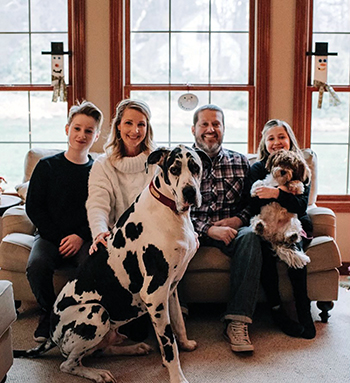Acute Lymphoblastic Leukemia Survivor
Having purpose and finding focus can guide you through

Garrison Wollam is a husband, father, author and third grade teacher who is managing acute lymphoblastic leukemia (ALL). After intense treatments and maintenance therapy, he is thankful for his positive prognosis and focuses on giving back.
Acute lymphoblastic leukemia affects kids more than adults, so it seems fitting that I’d have that type of cancer. I’m basically a big kid. I goof around and can be myself with the eight- and nine-year olds I teach. That’s how I’ve made it through a cancer diagnosis and treatment. That, along with my wife Chrissy, an amazing support system and enough chemotherapy to take down an elephant.
By the time I was diagnosed, I hadn’t felt well for a while. I was extremely tired and had swollen lymph nodes. It was even hard to breathe. After three visits in one month to my general practitioner, inconsistencies were found in my blood work. I was referred to a hematologist who, after running more tests, called me at home one evening.
The phrase “you need to sit down for this” is no exaggeration. When he said I had either acute lymphoma or acute leukemia and needed to get to a nearby cancer center that evening, I felt weak. I called my parents to stay with our kids and my school to let them know I’d need a substitute for the next day, and Chrissy and I drove an hour to the cancer center.
Five days later, I learned I had ALL. From the beginning, my prognosis was good because I had certain factors on my side. I was young – 37 – and relatively healthy. I was at a very good cancer center, and I had a positive attitude.
I didn’t know much about ALL, and I made the mistake of looking it up online. Don’t ever do that. Ask your doctor or nurse for legit resources.
It’s difficult to bring your kids into a big hospital that says “cancer” on the side without telling them something. Our seven-year- old daughter immediately looked at my wife and asked, “Is Daddy going to die?” It was heartbreaking. We told her I wasn’t, of course, but we didn’t know. That’s when we decided we wouldn’t give them the exact diagnosis. Our nine-year-old son was pretty savvy. We didn’t want him researching it on his own.
Treatment began the day I was diagnosed. I had a port placed. I call it my alien button because that’s what it looks like. Induction chemotherapy kept me in the hospital for about a month. Apparently, ALL likes to hide in the spinal fluid, so lumbar injections and radiation therapy to my head were also included.
I continued the chemotherapy regimen after coming home. Not teaching and not being around people made me feel as if I were losing purpose, but my kids motivated me to stay positive. Every morning, I helped Chrissy make their lunches and get them off to school.
I also took the opportunity to cross something off my bucket list. I’d always wanted to write children’s books. My main character, Buster Sluggless, had been floating around in my head for years. Suddenly, everything that prevented me from writing before vanished. So far, Buster Sluggless has had two adventures. I’ve also published a children’s poetry book, Boogers, Bugs and Hugs from Slugs and Daddy’s Orange Bracelet, a book about my cancer from my daughter’s perspective. It’s heavy, and not for everyone, but hopefully helpful to the small audience that needs it. Our son illustrated it, which makes it even more special.
I went into remission fairly quickly. I’m still on maintenance therapy. It’s a clinical trial that tests the regimen usually used on kids but in an adult dose. So far, my numbers are where they should be.
In some ways, I think this was harder on Chrissy than on me. She’s also an elementary school teacher, and she had to continue working, taking care of the kids, running the house, visiting me in the hospital and then taking care of me once I came home. I would have missed appointments and medications if she hadn’t managed everything. She is incredible.
Chrissy and I often said, “Cancer is dumb. So dumb. It’s the dumbest.” Those simple phrases just seemed to capture the whole terrible situation and wearing an “F cancer” shirt didn’t fit with my life as an elementary school teacher or parent. So, I trademarked the phrase “Cancer is dumb” and put it on T-shirts. I sell them at Cancerisdumb91.com and out of our home, and we donate 20 percent of the proceeds to St. Jude Children’s Research Hospital. I’ve always been a supporter, but now that I’ve experienced cancer treatment, I can’t imagine a child having to go through what I have. To help my students understand the benefits of giving back, we call St. Jude’s from the classroom when I make my monthly donations.
Cancer has given me a new perspective. I found there is more good out there than we sometimes see. People are far more compassionate and generous than I ever gave them credit for. While I was in the hospital, my bank account, car, house and sports memorabilia collection didn’t visit me once, but my family and friends did. That meant so much. It’s the best thing you can do for someone who is sick.


